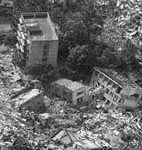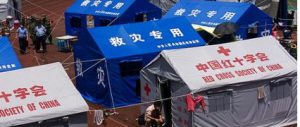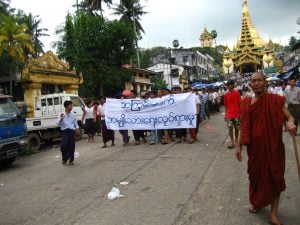Large mining trucks shuttled back and forth over the levelled top of Longmen Mountain, as rocks tumbled down the steep slopes. In the dense forest below, white rockfall scars were clearly visible through the trees.
This was the scene at the open-cast mining site owned by Lafarge’s Dujiangyan concrete plant, observed by Yang Yong, a geologist who in August carried out a two-week survey of the earthquake-struck Longmen mountains in Sichuan province, south-west China. “After the Wenchuan earthquake, businesses had the opportunity to move in and expand, and a number of new mining areas were opened up in Longmen. We need to be wary of this,” said Yang.
Head of the Hengduan Mountains Research Association and an expert at the China Foundation for Desertification Control, Yang has made a name for himself conducting independent investigations like this one. His interest in the Wenchuan region stretches back 15 years and he has spent the last three studying the effects of the devastating 2008 earthquake.
Yang is increasingly concerned about the path rehabilitation of the region has taken. “Reconstruction projects and the revival of mining industries have put a lot of pressure on the local geology and environmental capacity,” Yang told Southern Weekend on September 11. He is worried that secondary disasters such as mudslides and building collapses will cause more problems for post-disaster relocation projects than anticipated, and that some reconstruction schemes and new and expanding mines, exacerbated by poor environmental and safety management, will worsen those risks.
The area Yang investigated is the Longmenshan fault zone, located between the Sichuan basin and the Qinghai-Tibetan Plateau. The fault, which runs 300 kilometres in length, was the cause of the devastating Wenchuan earthquake of 2008 and of numerous geological disasters before that, affecting more than 100 cities and towns in Sichuan, Gansu and Shaanxi provinces. Earthquakes and mudslides, combined with years of mining in this mineral-rich area, have already caused serious damage.
Secondary disasters in the Wenchuan earthquake zone are growing both in degree of damage inflicted and size of area affected, according to Ma Dongtao, a researcher at the Chengdu Institute of Mountain Hazards and Environment, who said the problem would continue for decades, perhaps even as long as 100 years.
Liu Ping, former head of local Caijiagang village said that mudslides were not particularly frequent before the earthquake, but now they are common. “When it rains heavily, there’s a mudslide. It has been like this ever since the earthquake. This year, we have had three already.”
During his August visit to Longmenshan, Yang saw the footprint of geological disasters everywhere. Mudslides had almost filled the Shikan river gully, making the narrow river bed a wide “stone highway”. During flood season, access to many villages gets cut off.
Local government investment in the area is increasing, but remains entirely inadequate. Media reports indicate that Sichuan invested 3 million yuan (US$471,000) in the year 2000, 100 million yuan (US$15.7 million) in 2006 and 2 billion yuan (US$313.7 million) in 2011. Sichuan has over 20,000 indentified geological danger points, 2,300 of them listed as key targets for preventative measures. 200 million yuan (US$31.4 million) has been spent on mudslide prevention at the Wenjiagou gully in Mianzhu county alone. Yang said: “These projects still need time, funding and feasibility studies.”
Yang believes that post-earthquake reconstruction offered the region an opportunity to upgrade local industry and improve the environment, but that that opportunity has so far been missed. As work has gone on, it has become increasingly clear that a different path is being taken, he said.
He is most concerned about the recovery and expansion of industry and mining along the Longmen mountain range. “The vast numbers of factory chimneys you can see and all the new equipment show that, while some small plants may have been shut down, the phosphorus industry in Deyang and Mianyang is bigger and more concentrated than before the earthquake, and feeding that industry will require more mining of phosphate-containing minerals,” Yang said.
There are also new concrete plants at several locations in the area, including Beichuan, Pengzhou and Dujiangyan, notably new projects from Lafarge, which is a French building materials giant, and the Zhonglian Group. The raw materials for these operations come from the large open-cast mines in the Longmen mountains.
Lafarge’s environmental impact assessment on the expansion of its mining operations states: “Post-earthquake reconstruction will require large quantities of high-quality concrete, and there is a significant gap in market supply.” In 2009, the company announced that it was preparing to increase production and, as a result, would expand limestone and shale mining. Those mines are located in Dujiangyan.
Besides the impact of industry and mining on local geology, expansion may also increase pollution. “A number of polluting and energy-hungry industries have rebuilt and expanded in the Minjiang valley and the Longmen mountains – and these areas are where the Chengdu–Mianyang–Guanghan economic zone and the cities of the Chengdu plain get their water from,” said Yang.
Liu Ping of Caijiagang village is already aware of this negative impact. “Crops aren’t harvested now, cash crops like kiwi fruit and medicinal herbs don’t grow and the trees on the hillsides are starting to die off.” The villagers suspect an aluminium plant nearby, rebuilt after the earthquake, is to blame. An employee of the plant, surnamed Li, who has worked there for 14 years, told Southern Weekend that environmental-protection equipment wasn’t put in place during reconstruction in 2008, and is only just now arriving.
“Mines and factories damaged by the quake need to get producing again, and the government wants to see fast progress. But in such rushed circumstances, consideration and caution can get left behind, meaning dangers go unnoticed,” said Yang Yong in an interview with environmental NGO Friends of Nature to mark the second anniversary of the disaster.
There should have been a proper environmental approval process for industrial expansion and rebuilding, but in fact this process has been little more than a formality. As the report for the Lafarge expansion says: “The tailings area is at risk from soil erosion and geological disaster,” but “the mining techniques used meet the requirements for retaining soil and protecting the environment, and in this respect the project is reasonable and feasible.”
Yang believes that the Longmen mountains area will struggle to withstand further destruction. He has previously written that “the Longmen fault zone has already seen widespread and large-scale mining. Deposits above 2,500 metres have already been stripped bare. After the Wenchuan earthquake, this area suffered the worst secondary disasters and has become home to a large cluster of geological dangers and potential mudslides.”
Each year during seasonal floods, roads in the mining area get damaged, making access difficult, and the authorities have ordered that mining should halt during this period. It is clear that expanding mining operations has a far-reaching impact and needs to be evaluated carefully. But for the sake of rapid recovery, many projects have been rushed through a simplified approval process. “We have evaluated lots of projects related to geological disasters. In the past, the process took two or three years, but now it’s just one or two, or there isn’t even an approval process,” explained Tang Bangxing, another researcher at Chengdu Institute of Mountain Hazards and Environment.
Speed is not the only aspect of the approvals process that concerns Yang. “There is virtually no public participation in China’s environmental assessments,” he said. “We urgently need more public participation and awareness of public participation. Environmental assessments ignore a whole range of interests, and there aren’t any mechanisms powerful enough to force the relevant companies to take responsibility.”
“The primary goals at each stage are different,” said Ma Dongtao. “Just after the earthquake, emergency repairs and resettlement were the priority. But that was three years ago, and problems are starting to emerge. Everything needs to be calmly considered and approached scientifically – it is time to pay for our earlier rashness.”
This article was first published by Southern Weekend, where Wang Tao is a reporter.
Homepage image by Bill Stranberg.





